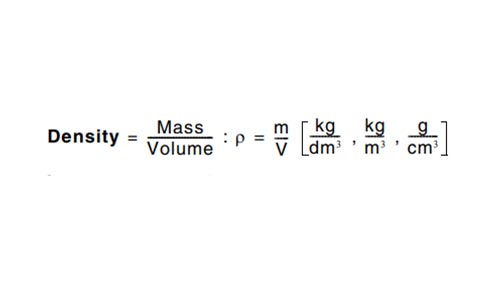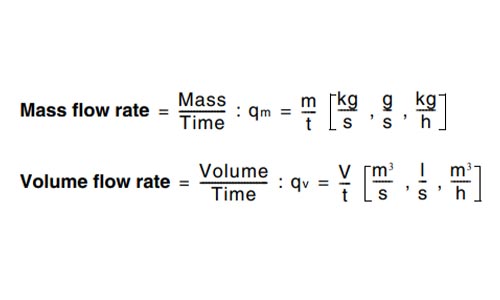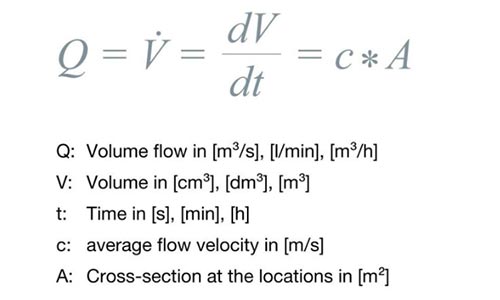Anemometer: Basics And Fundamentals
Introduction To The Physics of Flow Rate And Total Flow Measurements
Measured Variables
Measurement technology presents devices for optimizing production processes and dosing operations. Besides pressure and temperature, the flow rate is considered one of the most significant measured variables.
The quantitative determination of the amount, volume, and flow rate permits the optimization of production processes through control and regulation. Mass and volume are the essential fundamental values:
m is the symbol for mass measured in kg or g
V is the symbol for Volume measured in m3, dm3, or cm3.
The density describes the relationship between both values as a ratio of mass to volume.

Since most production systems have a continuous operation, the measured values must indicate the instantaneous conditions or the instantaneous values. So, the flow rate as a time-dependent value is essential.Mass and volume are used to make a distinction between the mass flow rate qm and the volume flow rate qv:

Since the mass flow rate is independent of pressure and temperature, it is defined as the ideal measurement value. Also, the volume flow rate is preferred because it is technically more convenient to measure.
The pressure does not affect the volumes of the incompressible liquids in the ranges usually encountered. However, temperature changes cause volume changes, which sometimes need correction measures.
Basics for Measuring The Airflow
There are three methods used to measure the flow velocity. Due to their measuring range and the operating temperature, these methods are notably different from each other:
- Pitot tubes
- Rotating vanes
- Thermo Anemometer probes
Pitot Tubes
In this method, dynamic pressure and static pressure measure air velocity. Pitot tube bodies are made of special steel or nickel-plated brass. Silicone hoses and a differential pressure module connect Pitot tubes to ALMEMO® devices.
Advantage:
This method is ideal for high flow velocities, harsh operating conditions, and high ambient temperatures.
Disadvantage:
- Extremely directional
- Low flow velocities can not be measured
- Temperature-dependent
- Restricted accuracy
- Vulnerable to turbulent flows
Rotating Vanes
The rotating vane determines the flow velocity through a frequency measurement. They are sensitive sensors with diamond bearings that are precisely adjusted to provide high accuracy.
Advantage:
- The high accurate result at medium flow velocities and medium ambient temperatures
- Invulnerable to turbulent flows
Disadvantage:
- Sensitive sensor technology
- Vulnerable to mechanical stress
- Directional
Thermo Anemometer
Also called thermistors or hot wire anemometers, these sensitive sensors determine the flow velocity by monitoring the amount of heat. Their measuring element should continuously heat up.
The element's temperature remains at a constant value with the help of a control circuit. The control current is compatible with the flow velocity.
Advantage:
- Low flow velocities can measure
- Direction-independent measurements
Disadvantage:
- Sensitive sensor technology
- Easily affected by mechanical stress and contamination
- Sensitive to turbulent flows
- High current use
- Restricted ambient temperature
Physical Principles Of The Measurement Parameter Flow Velocity
Directional movement of particles or continuous media is expressed as flow, such as water or gas flow. Meters per second (m/s) is the SI unit for flow velocity.
There is a difference between laminar flow (without turbulence) and turbulent flow (with turbulence) based on the occurrence of turbulence. Laminar and turbulent flow are two significant aspects to consider when measuring flow.
Generally, laminar flow happens when there are small pipes and low flow velocities at high flow rates and with larger pipes. A low Reynolds number shows laminar flow, while a high Reynolds number presents turbulent flow.
The behavior of flow varies if it is laminar vs. turbulent. Also, laminar flows are smooth and streamlined, while turbulent flows are irregular and chaotic. In complicated systems, the analysis of laminar and turbulent flow is essential for efficient operational design.
Air Volume Flow
A volumetric flow is the volume of a medium that moves through a cross-section in a certain period of time.
Usually, it indicated in l/s or in m³/h that the conversion calculation is: 1000 l = 1 m³ and 3600 s = 1 h and the conversion factor is: 1 l/s = 3.6 m³/h or 1 m³/h =0.27777777777778 l/s.
The Formula for Volume Flow

Introduction To Air Velocity Measurement
Airflow measurement is a critical part when assessing different systems. It ensures the balance, energy efficiency, and cost-effectiveness of the systems.
Airflow measurement instrumentation is one of the most effective methods to test and confirm components. These test instruments are known as anemometers or thermo anemometers.
Many anemometers determine airflow, air volume, and temperature, but other parameters may be measured, such as humidity, dew point, and static/differential pressure.
Air velocity (distance moved per unit of time) is typically defined as feet per minute (FPM). Air volume flowing past a point in the duct is measured by multiplying air velocity by the cross-section area of a duct.
Velocity measurements are suitable for use with engineering handbooks or design information to present the proper or improper performance. Also, in working with pneumatic conveying, flue gas flow, and process gas systems, the same principles are practical to determine velocity.
What is Wind Speed?
Wind speed is typically expressed as the velocity of the wind. In meteorology, it is defined as air movement in the atmosphere from high pressure to low pressure because of temperature changes.
The wind speed may be averaged over a specific unit of time, such as miles per hour or an instantaneous speed. Wind speeds typically indicate the movement of air in an outside environment, but the speed of movement of air inside is also significant in many conditions.
What Units Are Used to Measure Wind Speed?
Usually, the wind speed unit is Meters per second (m/s), the SI unit for velocity, and the unit suggested by the World Meteorological Organization for indicating wind speeds. Also, it is used in weather forecasts in Nordic countries.
ICAO, or the International Civil Aviation Organization, suggests meters per second present wind speed when approaching runways instead of kilometers per hour (km/h).
Miles per hour (mph), knots (kn), or feet per second (ft/s) are other units that are sometimes used to determine wind speeds. One of the first units for measuring wind is the Beaufort scale. It determines the wind speed via visual observations of wind effects at sea or on land.
What Is An Anemometer?
An anemometer, also called a wind anemometer, is a device used to measure the wind's speed, intensity, amplitude, and direction. Anemometers are essential devices at weather stations used by meteorologists to analyze what conditions occur.
Also, physicists use it to consider the course of airflow. They are ideal for determining gas velocity and velocity in enclosed flow, such as airflow in a duct, or unlimited flows, such as atmospheric wind.
For measuring the speed, the anemometer detects changes in some physical properties of the fluid or the fluid effect on the mechanical device entered into the flow.
Usually, anemometers are classified as:
Constant-Temperature Anemometers (CTA)
The constant temperature anemometer or CTA, also known as the thermal anemometer, is a thermal flow measurement tool. CTA is incredibly well suited for measuring flow velocities with fast fluctuations at a point. Also, it is necessary to study flow microstructures to resolve small flow eddies down to the order of tenths of a millimeter.
CTA operates based on the cooling effect of a flow on a heated body. It is an electronic system with a feedback loop that keeps the temperature of a flow sensor, heated by an electric current, at a constant, determined level. These current results measure the heat transfer intensity between the sensor and the tested flow.
Constant-Power Anemometers
The constant voltage anemometer or CVA is used for high-performance flow measurements. The CVA provides real-time measurement of fluctuating velocity and temperature in air and gasses. It is done without careful tuning of its frequency response.
The CVA principle of operation is based on the combination with a hot-wire sensor located in the flow under analysis. Due to transmitting convective heat between wire and current, the resistance of the wire changes and is converted to an output voltage by the CVA circuit.
So, analyzing the output voltage finally provides a way to check and explore the features of the flow. CVA provides high-frequency response and low noise characteristics, so it is especially ideal for turbulent flows with significant frequency content or low turbulent intensity.
What Units Does The Anemometer Measure In?
Anemometers measure wind speed in feet per minute (FPM). A magnetic or optical sensor detects the rotation of the wind that converts the signal to FPM measurement. Also, there are other units used to report wind speed, including miles per hour (MPH), kilometers per hour (kph), SI unit meters per second (m/s), or knots.
Conversion From MPH To m/s
For converting from MPH to m/s, you should divide by about two and a quarter:
(1 mi/hr) = ( mi/1,609 m) (3600 s/hr) = 0.447 m/s
Where mi = mile, m = meter, hr = hour, s = second
You can also read the following article to get more familiar with anemometer:
What is The Use of Anemometer; Details You Need to Know About Wind Meter
Anemometers Industries And Applications
Everything About Top 3 Anemometer Manufacturers in UAE
Recent Posts
-
Booster Pump Troubleshooting and Maintenance: How to Fix and Prevent Common Issues
1. Introduction Imagine turning on your faucet only to be greeted with a weak trickle of water when …22nd Apr 2025 -
Energy-Efficient Booster Pumps: Selection and Tips for Maximizing Performance
1. Introduction Imagine never having to deal with fluctuating water pressure, noisy pumps, or skyroc …19th Apr 2025 -
Booster Pumps for Sustainable Water Systems: Irrigation and Rainwater Harvesting Solutions
1. Introduction Water scarcity is no longer a distant threat—it’s a reality affecting millions …16th Apr 2025




